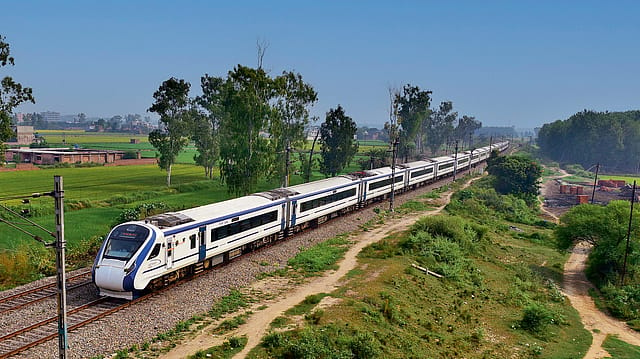Race On To Meet Vande Bharat Targets

ON FEBRUARY 12, while flagging off two more Vande Bharat Express trains, Prime Minister Narendra Modi said the train was a reflection of India's "speed and scale". Modi dedicated the indigenous high-speed trains between Mumbai-Solapur and Mumbai-Shirdi to the nation, taking the total number of Vande Bharats currently in operation to 10.
This, however, is just the beginning as the government has set lofty goals for the Ministry of Railways. It has to deliver 75 such trains by August 15, as a commemoration of the 75th anniversary of India's independence.
For the ministry, which has a current capacity of one train per week, both 75 units by August 15 and 400 more trains in the next three years are undoubtedly a daunting task. It is trying to move expeditiously ahead with plans for capacity expansion in its own units and by roping in the private sector. In the process, the entire ecosystem of the bulk indigenous manufacturing of semi-high speed trains offers a ₹22,000 crore procurement opportunity to domestic suppliers, providing a fillip to Make in India and a cushion against the global economic slowdown.
Vande Bharat train is an indigenously designed electric multiple unit, which is not hauled by a locomotive and has a top speed of 180 km per hour. The operational speed is 130 km per hour, and the train has the capacity to accelerate to 100 km per hour in 52 seconds. It is equipped with indigenously developed train collision avoidance system, which enables self-braking in the event of the driver overshooting signals, or when two trains are on a collision course.
Capacity Expansion
To meet its deliverables of 75 Vande Bharat trains by August 15 this year, the railway ministry plans to press two more manufacturing units into action, and is targeting production of two to three train sets per week by the end of FY24 from one per week as of now. Currently, the Vande Bharat rakes are being manufactured in the Integral Coach Factory (ICF) under the railway ministry. The ICF is manufacturing 78 Vande Bharat trains along with Punjab-based Medha Engineering.
"We have to ramp up production and supply chain. This year, we will expand production to three more facilities. Right now we are doing one Vande Bharat every seven days," Railway Minister Ashwini Vaishnaw said. The three units are Sonipat (Haryana), Rae Bareli (U.P.) and Latur (Maharashtra).
Apart from capacity augmentation in its own units, the ministry is roping in the private sector as well. It floated a ₹26,000 crore tender last year for 200 additional trains, and received encouraging response. According to sources, major players that have evinced interest include Alstom, Swiss railway rolling stock maker Stadler in collaboration with Medha, Siemens-BEML consortium, BHEL-Titagarh Wagons consortium and Russian major Tranmashholding.
Made In India
Vande Bharat trains have built an ecosystem of domestic procurement, which comes as a boost to suppliers of stainless steel, electrical and mechanical components, at a time when the world is staring at a recession. Around 85% of the components that go into the manufacture of Vande Bharat trains are procured locally, says a source in the railway ministry. "Chips and semiconductors used in the electronic systems are being imported. Some components related to the wheels, too, are being imported. But the dependence on imports is not more than 15%," he adds.
With mega plans of a large-scale rollout in the next three years, domestic suppliers can be assured of steady demand, and a pipeline that is unlikely to dry up anytime soon. To put the number in perspective, at 85% of local procurement, domestic suppliers will have opportunities worth ₹22,000 crore in the ongoing tender and a similar amount in the tender for the next 200 trainsets. It will be a huge opportunity for both steel and aluminium companies as the first 200 trains will be stainless steel based, while the next 200 will be made out of aluminium, according to the railway ministry source.
Key Concerns
While mega plans are afoot regarding the manufacture of Vande Bharat rakes, for high-speed train travel, railway tracks, too, need to be upgraded. Even though the Vande Bharat Express is designed for a speed of 180 kilometre per hour, its current operational speed is only 130 km per hour. The issue needs to be addressed.
Another pain point pertains to coach hiccups. Incidents of last-minute change of Vande Bharat rake to Tejas rake have come to the fore. Rachit Chopra, a Greater Noida resident was in for a rude shock when his Delhi-Katra Vande Bharat express on February 9 was swapped with a Tejas rake. "We paid for travel in Vande Bharat. Why should the railways force us to travel in a Tejas rake?," says Chopra. Another passenger concern pertains to the reduced number of toilets to two from the earlier four per coach, and overhead space not large enough to accommodate slightly bigger luggage.
One of the key tenets of Vande Bharat apart from indigenous technology and manufacturing is enhanced customer experience and high-speed travel. Railways needs to ensure that operational issues do not jeopardise passenger interest.